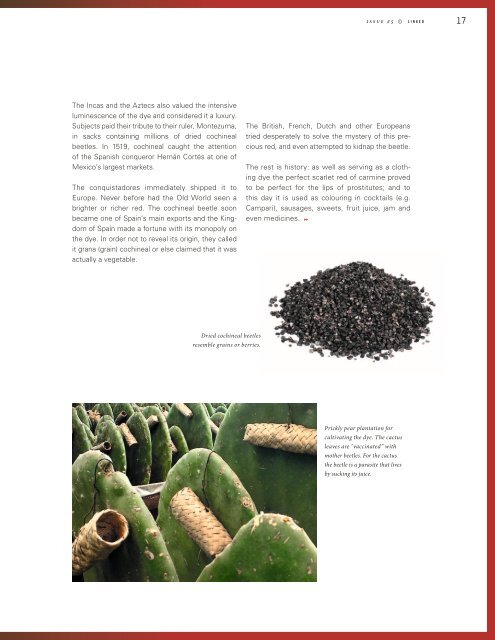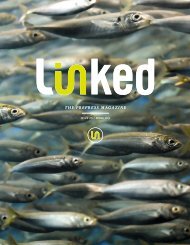Create successful ePaper yourself
Turn your PDF publications into a flip-book with our unique Google optimized e-Paper software.
issue #5 ©<br />
l i n k e d<br />
17<br />
The Incas and the Aztecs also valued the intensive<br />
luminescence of the dye and considered it a luxury.<br />
Subjects paid their tribute to their ruler, Montezuma,<br />
in sacks containing millions of dried cochineal<br />
beetles. In 1519, cochineal caught the attention<br />
of the Spanish conqueror Hernán Cortés at one of<br />
Mexico’s largest markets.<br />
The conquistadores immediately shipped it to<br />
Europe. Never before had the Old World seen a<br />
brighter or richer red. The cochineal beetle soon<br />
became one of Spain’s main exports and the Kingdom<br />
of Spain made a fortune with its monopoly on<br />
the dye. In order not to reveal its origin, they called<br />
it grana (grain) cochineal or else claimed that it was<br />
actually a vegetable.<br />
The British, French, Dutch and other Europeans<br />
tried desperately to solve the mystery of this precious<br />
red, and even attempted to kidnap the beetle.<br />
The rest is history: as well as serving as a clothing<br />
dye the perfect scarlet red of carmine proved<br />
to be perfect for the lips of prostitutes; and to<br />
this day it is used as colouring in cocktails (e.g.<br />
Campari), sausages, sweets, fruit juice, jam and<br />
even medicines.<br />
Dried cochineal beetles<br />
resemble grains or berries.<br />
Prickly pear plantation for<br />
cultivating the dye. The cactus<br />
leaves are "vaccinated” with<br />
mother beetles. For the cactus<br />
the beetle is a parasite that lives<br />
by sucking its juice.









